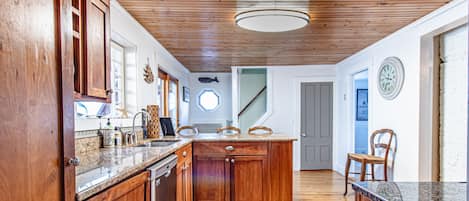Great location, great views. Our 33rd Anniversary trip. Safety issues, not recommended for younger children or those with mobility issues. The path to the cottage is somewhat steep and made of deep, small, loose pebbles which make footing precarious. The 3 stone steps going further down to the cottage get pebbles on them and they are already uneven. You will need to carry your luggage up and down the pathway, you will not be able to use your rollers. 17 moderately steep stairs up to the sleeping area. Shower curtain and rugs, wash or replace. Note left for us that the upstairs bathroom latch may lock us into the bathroom and needed 'attention'. Rails on upper deck were rotten an loose, painted over instead of replaced. One new fan and one filthy fan provided. It may be difficult to keep cool in warmer months, we stayed at the end of May. We washed some of our dishes before use, they were put away unclean. You will need to buy oils, spices, condiments, etc. There were some basics, salt, pepper, sugar, flower. We left ours behind for other to use. Modest kitchen cookware, you can probably make it work. Unfortunately, because of the way the property sits there is full view of the living room, both decks, the bed in the upstairs bedroom from the main house. If you want a privacy pull the curtains which then shuts out the view. There was A LOT of work done we needed to navigate people, tools, vehicles parked in the small parking area, and could not enjoy the outdoor areas.






